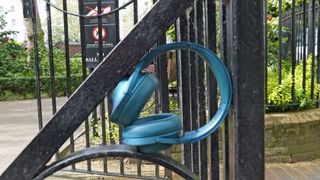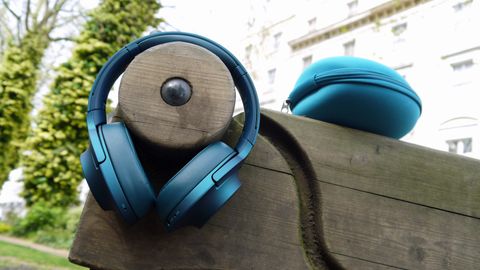TechRadar Verdict
Stunning to look at and fantastic to listen to, the latest in the H.ear On range proves once again that Sony is up there with the best when it comes to manufacturing high-quality headphones.
Pros
- +
Exceptional comfort
- +
Long battery life
- +
Brilliant Hi-Res Audio functionality
- +
Stylish look
Cons
- -
Lack of low-battery warning
- -
No touch controls
- -
Wireless Hi-Res Audio only available through LDAC devices
Why you can trust TechRadar
Take a quick look at Sony's latest H.ear On headphones (shoot me, but I actually like the name pun) and you'd be forgiven for thinking you'd seen them before. This is because they share the same design flourishes as a set of headphones the company released at the tail end of 2015, the MDR-100AAPs.
I have no problems with Sony using the same design – the 100ABNs are the best-looking headphones Sony has made in recent years. The design is clean, minimal but oh-so stylish. I've been using a Viridian Blue pair (essentially posh turquoise) for a number of weeks, and they're head-turners.
The use of a single shimmering color complements the single-shape design that's, granted, a touch on the bulky side, but this isn't noticeable when they're worn.
Features and design
Put the H.ear Ons, er, on and you're immediately comforted by the padding on top of the adjustable headband and the soft ear cups. At 290g these certainly aren't light headphones, but they aren't heavy on the head, just nice and solid.
The minimal design is only broken up by etched Sony branding on either side of the band, an NFC logo on the right side and the word 'wireless' on the band's curve.
Wireless functionality is the big differentiator between these and the MDR-100AAP H.ear Ons. While there is a cable in the box, wireless connectivity is fantastic, with connection to your chosen device pretty swift.

I mostly used Bluetooth to connect, but NFC was quick too. Once they link your device a female voice tells you that everything is connected. The only other time you hear this voice is if you want to know how much battery is left in the headphones. Hold down the power button – found on the ridge of the left ear cup – and you'll get a 'battery level is high/medium/low' response.
Annoyingly, I never heard an automatic 'battery is low' warning, which does mean that sometimes the MDR-100AAPs cut out at inopportune times, with the abrupt message: 'please recharge your headset'. It's akin to a DJ stopping mid-tune in a club, and turning the lights on while you're still on the dancefloor.
Thankfully, however, there's plenty of charge in these headphones – more on this later – so unexpected cut-outs aren't going to happen very often.
NFC functionality is also found on the left ear cup, as are the mic, headphone jack port and a button to toggle the noise cancelling on and off.

On the right side are physical buttons for volume control and play/pause/track-skipping. I would have loved these to have been integrated into the right ear cup as touch controls, but they're fine to use; they just feel a little out of place on a pair of headphones that seem to pride themselves on minimal design.
While I'm on the subject of niggles, I did have a little trouble trying to connect two of my devices to the headphones. It didn't happen all the time, but sometimes when I had my Samsung Galaxy S6 Edge connected, then tried to link up my iPad Air too, the tablet would show as connected but then music would start blaring out of its speaker, much to the annoyance of people on my commute.
It happened more than once, but it wasn't something I could replicate easily, so it may just be a minor glitch, or a problem with the devices I was using. For the most part, though, connecting was really simple.
Performance
If you haven't done so yet, then take my advice: invest in a pair of noise-cancelling headphones. Right now. The drone of real life may be something you think you don't notice, but hit that ANC (active noise cancelling) button and your ears will thank you forever.
But while noise cancelling is great in itself, for it to work effectively you need to have headphones in which it's well implemented. There's a reason Bose's QuietComfort cans sell so well: the noise cancelling is always exceptional, and perfect for the business person on a long-haul flight.
The H.ear Ons don't quite reach those noise-cancelling heights. Don't get me wrong; the noise cancelling is really effective, and stops most ambient noise dead, but some noises do get through.

You're not going crazy if you think you can hear whispered voices with the MDR-100ABNs on, you can; it's one of the sounds that seems to slip through the ANC net. Voices are hushed, but still audible if your music isn't turned up to a certain point.
That said, the ANC never once impinged on the quality of the music I listened too, which is a common issue with some headphones.
There's a decent amount of heft within the 100ABNs to make your music sound expansive. Two 40mm drivers are present that will push a frequency of up to 40KHz, which is why these headphones carry the Hi-Res Audio stamp. While some similar-sized headphones have 45mm drivers in them, the detail in the tracks here was still outstanding.
Radiohead's Present Tense sounded beautiful – you can hear the squeak of Jonny Greenwood's fretwork on the track, while the background choral chants envelop your ears. Songs with bigger bass also work exceptionally well. Track Uno by Canadian DJ Kaytranada bounces off the drivers, offering up a booming low end but also managing to capture the tut-tutting of the hi-hat.

I was never disappointed with what I heard, but I'd have liked to have tried out the LDAC capabilities of the headphones. This is a codec by Sony that offers up near-Hi-Res Audio streaming – three times the performance of Bluetooth – but only if you have a compatible device, such as Sony's Hi-Res-ready Walkman.
Instead, I got my Hi-Res Audio kicks from my portable Mojo DAC, Tidal and by plugging the headphone cord into the H.ear Ons. Timeless by James Blake in Hi-Res sounded haunting and utterly crisp.
Even with ANC on, I managed to get a good 20 hours out of the MDR-100ABNs before having to recharge them, so there are no issues in that department. And when you are finally done with them for the day – and they're so comfortable, you could wear them all day – they fold up nicely, and can be tucked away in their semi-solid hard case.
We liked
The Sony H.ear On MDR-100ABNs are some of the most comfortable headphones around, as well as being really stylish. They aren't as garish as, say, Beats – and they sound a hell of a lot better than that brand too.
We disliked
The occasional failure to connect when trying to pair two devices is a little annoying, as is the noise cancelling not cancelling everything out; this does make a difference, but while there are better headphones out there for pure noise cancelling for a similar price – the Bose QuietComforts being one example – they don't match the look and design of the Sonys.
Final verdict
Lovely to wear, great to look at and fantastic for sound, the Sony H.ear On MDR-100ABNs would be a fine buy for anyone looking for noise-cancelling wireless headphones with the added bonus of Hi-Res Audio.
They aren't cheap, though. Priced at £220/$350 (around $AU480) they'll certainly be at the higher end of most budgets – but I wouldn't hesitate to hand over that sort of money for headphones that have enough tech in them to last years.
Marc Chacksfield is the Editor In Chief, Shortlist.com at DC Thomson. He started out life as a movie writer for numerous (now defunct) magazines and soon found himself online - editing a gaggle of gadget sites, including TechRadar, Digital Camera World and Tom's Guide UK. At Shortlist you'll find him mostly writing about movies and tech, so no change there then.

Scientists inch closer to holy grail of memory breakthrough — producing tech that combines NAND and RAM features could be much cheaper to produce and consume far less power

Google adds biometric verification to Play Store to keep your in-store wallet safe

Quordle today – hints and answers for Wednesday, April 17 (game #814)

